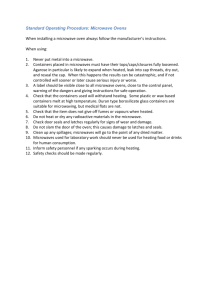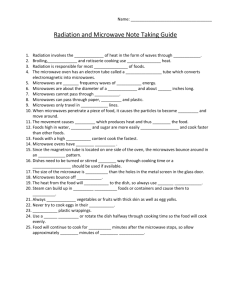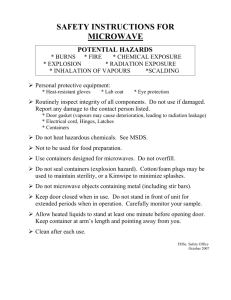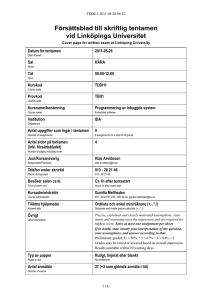Försättsblad till tentamen vid Linköpings Universitet
advertisement
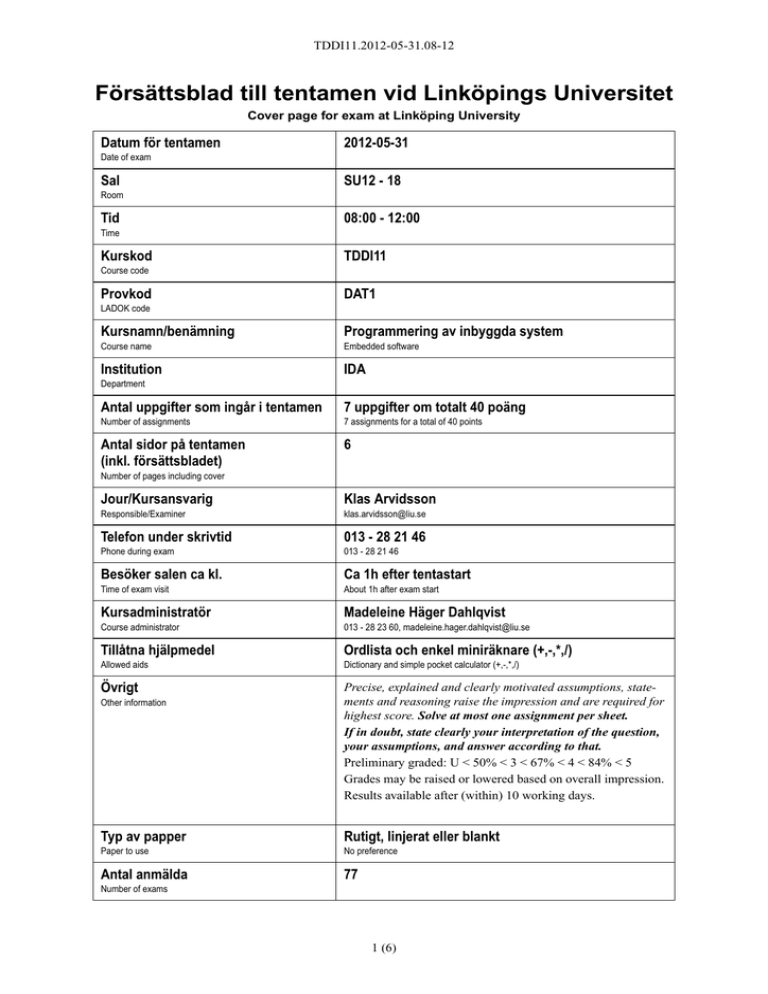
TDDI11.2012-05-31.08-12 Försättsblad till tentamen vid Linköpings Universitet Cover page for exam at Linköping University Datum för tentamen 2012-05-31 Date of exam Sal SU12 - 18 Room Tid 08:00 - 12:00 Time Kurskod TDDI11 Course code Provkod DAT1 LADOK code Kursnamn/benämning Programmering av inbyggda system Course name Embedded software Institution IDA Department Antal uppgifter som ingår i tentamen 7 uppgifter om totalt 40 poäng Number of assignments 7 assignments for a total of 40 points Antal sidor på tentamen (inkl. försättsbladet) 6 Number of pages including cover Jour/Kursansvarig Klas Arvidsson Responsible/Examiner klas.arvidsson@liu.se Telefon under skrivtid 013 - 28 21 46 Phone during exam 013 - 28 21 46 Besöker salen ca kl. Ca 1h efter tentastart Time of exam visit About 1h after exam start Kursadministratör Madeleine Häger Dahlqvist Course administrator 013 - 28 23 60, madeleine.hager.dahlqvist@liu.se Tillåtna hjälpmedel Ordlista och enkel miniräknare (+,-,*,/) Allowed aids Dictionary and simple pocket calculator (+,-,*,/) Övrigt Precise, explained and clearly motivated assumptions, statements and reasoning raise the impression and are required for highest score. Solve at most one assignment per sheet. If in doubt, state clearly your interpretation of the question, your assumptions, and answer according to that. Preliminary graded: U < 50% < 3 < 67% < 4 < 84% < 5 Grades may be raised or lowered based on overall impression. Results available after (within) 10 working days. Other information Typ av papper Rutigt, linjerat eller blankt Paper to use No preference Antal anmälda 77 Number of exams 1 (6) TDDI11.2012-05-31.08-12 General theory part (19p) Write your answers in the file “solutions.txt”. Save often. Solve all assignments you can answer fast first. Do not spend more than 1 hour on this part. Get started on the practical part early. Right-click the desktop to start emacs, a terminal and the communication client. 1. Definition of embedded system (3p) a) Describe four criteria that are said to distinguish an embedded system. We say it’s an embedded system when some or all of them is true. b) Give an example of an embedded application where at least two of the distinguishing criteria are found. Motivate. 2. This and that (5p) a) Embedded development sets many non-functional requirements on the system, such as unit cost or performance. List four other common and important such requirements. (2p) b) What is a semaphore and when do you use it? (2p) c) Explain the meaning of a memory map. (1p) 3. Assembly (3p) An 8-bit processor have two 8-bit registers for 8-bit arithmetic operations, reg1 and reg2. It also have the following assembly operations (the first operand is the destination): mov [ADR] regX ;; Move from register to memory mov regX [ADR] ;; Move from memory to register add regX regY ;; Addition, regX = regX + regY adc regX regY ;; Addition, regX = regX + regY + carry ;; Example, X represent the base address of some data mov reg1 [X+1] ;; Move second byte of X to reg1 Base addresses A, B and C each store one 16-bit integer. a) Show assembly code to perform the 16-bit addition C = A + B. Assume that reg1 and reg2 are free, and that no other registers exist. Both A and B must remain unmodified. (2p) b) Presume that operand B is specified to be 4-bits (the highest nibble in the byte is always zero). Can the 16-bit result overflow? If yes: how do you detect that? If no: why not? (1p) 4. Optimization (4p) At some point in the development process you may need to optimize code. a) At which point in the development process do you start to worry about optimizations? (1p) b) Suggest three things you may want to optimize (three goals of optimization). (1p) c) Describe two different methods to reach one of your goals in b). (2p) 5. Development methods (4p) a) Explain why using a development methodology is important. (1p) b) Give a compelling reason when you would use successive refinement model. (1p) c) Give a compelling reason when you would avoid successive refinement model. (1p) d) Give example of a development methodology other than successive refinement. (1p) 2 (6) TDDI11.2012-05-31.08-12 Microwave oven requirements and specification The essential parts of a microwave owen are: A microwave generator, A rotating tray, A door, A set of buttons, A display, A loudspeaker and a micro controller to tie it all together. All mentioned parts are available for you in this assignment. Your task is to write a program that behaves as a microwave oven. The requirements are: 1) Microwaves are not possible to turn on until the door has been opened and closed (every time). The assumption is that food is inserted during the time the oven is open, and that this requirement prevent us from starting the oven empty by mistake. 2) Microwaves are not possible to turn on unless a time is set. 3) The microwave generator is stopped within 50ms when the door is opened. This is required by safety regulations. 4) The time counts down when microwaves are on and is paused when microwaves are off. 5) Microwaves are turned off and the speaker beeps during 1 second when the time count down to zero. (It does not beep (or countdown) unless microwaves was on.) 6) Pressing the start button turn on microwaves and the rotation tray depending on 1) - 2). 7) Time can be set or modified at any time. The first 6 presses on the + button increment the display by 10 seconds. The next 6 presses increment by 20 seconds, and any more presses increment by one minute. Any press on the - button halves the set time. The micro controller uses three memory mapped registers, A, B and READY. A is 8-bit input, B is 8-bit output and READY is 8-bit input/output. The meaning of each bit is given below: bit input A output B READY door: inc: dec: start: beep: onoff: position: value: READY: 7 6 5 4 the high 4 bits are not used beep onoff position of digit 3 door 2 1 0 start dec inc value of digit on display set to false before update of display, autoset to true when display is ready This bit is 1 while the door is open. This bit is 1 while the + button is held down (no visual feedback). This bit is 1 while the - button is held down (no visual feedback). This bit is 1 while the S button is held down (no visual feedback). Speaker will beep while this is set to 1. Microwaves are on and tray rotates while this is 1. A two bit position value (0-3). This decide which of the four display digits that will be updated with the value in the low 4 bits of B. The digits are numbered left to right starting at 0. A four bit value (0-15) that determine one digit to show on the display. The device controlled by the output B is very slow. To guarantee that all changes to B is detected you can not write the next value too fast. The procedure to avoid writing a new value to B too early is to watch this READY signal. Before you update B you set READY to false. Then you write to B. As soon as READY reverts back to true B is ready to accept a new value. It is OK that the delay is noticeable on screen. 3 (6) TDDI11.2012-05-31.08-12 The system should be implemented by three modules (two as state machines). 1) One state machine, SET_TIME, should monitor the + and - buttons (inc and dec). The output of this state machine is time_set. time_set is 1 at all times when the time set by the user is above 0. A second output of this state machine is clock. clock is the actual time set on the display in seconds. The maximum clock is 99:59. This state machine should run every 200ms and is already implemented for you. It solves requirement 7. 2) A second state machine, HEAT, should use door, start, and time_set as inputs. Outputs should be beep, onoff and clock. It should solve requirements 1, 2, 4, 5 and 6. 3) A third function takes care of updating the display (position + value) with the current clock value. You can use seconds_to_display implemented later. Instructions If you are unable to solve one assignment, explain that and implement a simpler replacement for reduced points. Make sure to comment what your code is intended to do in order to get credits despite flaws. If you encounter small glitches and flaws that you think may affect your score, use the exam communication client to ask about it (do not spend time on a problem you are not sure you have to fix). Right-click the desktop to start emacs, a terminal and the communication client. To get started and check that the given files work you need to execute: cp given_files/Makefile . // remember the last dot cp given_files/main.c . // all your code go to main.c gmake // to compile ./main // to start application When this work correctly it will bring up a window presenting a (ugly?) microwave oven. The given code causes the owen to behave rather erratic. It will be your task to program the correct behavior of this microwave (see assignments below). 6. Practical implementation (computer part) (14p) Write all your code in “main.c”. Compile with “gmake”. a) Your first task is to implement the function set_display(int value). If, for example, value is the number 1234 the function should update the display to show 12:34. If value is 987654, then the display will show 76:54. The given code increment a counter and assign it to B over and over again. You can test your function by instead of assigning B call set_display. Take care not to modify beep or onoff bits. (6p) Hints: You will need your bit manipulation skill. Solve this in small steps and test between. How to write to value without affecting other bits? How to write position? How to update all four positions and not too fast? How is division by 10 and mod (%) by 10 useful? b) Implement another function seconds_to_display(int seconds) that set the given number of seconds on the display, but take minutes into account. If, for example, the function is called with an argument of 83 seconds it must show 01:23 on the display (one minute and 23 seconds). It is a simple calculation and a single call to set_display(123). (1p) c) (1) Draw the state machine for HEAT. Look at the specification on previous page. Do not use the provided state machine template sheet yet. (2) Implement the state machine for HEAT and test it carefully. (3) Make sure your implementation matches your drawing (or vice verse). (4) Then fill in the provided state machine template with your final version. (6p) d) Implement a main program that make sure each state machine is called at proper time intervals (observe requirement 3 and the intended period of SET_TIME). You should now have a working microwave oven implementation. (1p) 4 (6) TDDI11.2012-05-31.08-12 7. Implementation related theory (7p) Write your answers in the file “solutions.txt”. Save often. a) Is the given SET_TIME machine a Mealy or Moore machine? Motivate your answer. (1p) b) Both state machines update clock. Decide for yourself if this is a problem or not. Then use your best arguments to defend your decision. Good reasoning and motivation is the important thing for score, not the decision in itself. (2p) c) You notice that pressing the + or - button is sometimes not detected by the state machine, and sometimes detected twice before you release the button. Suggest a better implementation of the given state machine that solves this. (1p) d) Assume you do no have access to TimerSet nor TimerOn functions. Instead you have access to a low level 8-bit hardware counter connected to a 100kHz clock. It will generate an interrupt every time it overflows from 255 back to 0. Explain the code needed to reset timer_period_elapsed every 50ms by using this hardware counter. An exact measurement is important (give or take a microsecond). (2p) e) The following four timing diagrams show two updates of the slow display (output B) and the READY signal. Which version follow the specification for READY given on page 3? (1p) ________ __ READY \________/ \____ _______ ________ ________ 1) B _______X________X________ ________ READY B __ \________/ \____ _________ ___________ ___ _________X___________X___ ________ READY B 2) __ \________/ \____ _________ ______ ________ _________X______X________ ________ READY B __ \________/ \____ _______ _____________ ___ _______X_____________X___ 3) 4) Some people claim that more than 100% is impossible. Let’s put that statement to the test. Here’s an optional question that may push your score up to 42 (105%). Assume the door is connected to a low latency interrupt pin. Explain how you would improve the security of the implementation (see requirement 3) by using an interrupt handler for the door. What code do you need? How do you cooperate with the remaining system? (2p) When you are completely done with all assignments you right-click the desktop and select “Finish exam”. Click OK when asked to confirm, your files are saved even if the session is not. You get to a “relogin” page and should select “Quit” and confirm that. When you are back at the normal blue login screen you can leave. 5 (6) TDDI11.2012-05-31.08-12 State machine drawing template sheet Write state names in circle. Write action(s) on line(s) below circle. Draw transitions and state condition for each transition as needed. You do not have to use all circles. You may add additional states. You may ask for a new template. Inputs to this state machine:______________________________________________ Outputs to this state machine:_____________________________________________ Period this state machine run at:___________________________________________ 6 (6)

